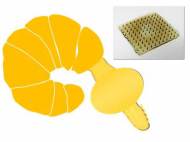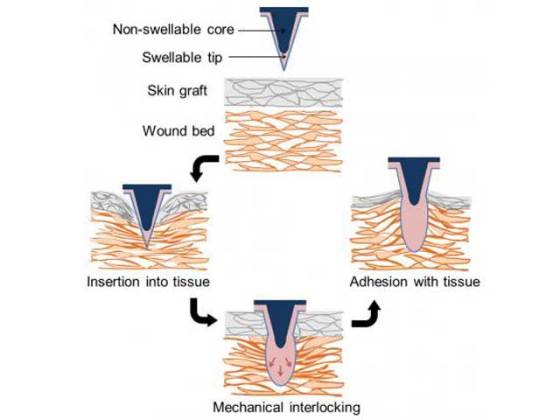Bioinspired microneedle adheres 3 times stronger than surgical staples
 Inspired by a fish parasitic worm, a group of researchers at Brigham and Women’s Hospital (BWH) devised a way to close surgical wounds that appears better than anything currently available for clinical use. Once perfected, the invention could be used as replacement for staples and sutures used in the operating room, as well as to deliver therapeutics and lower the chances of inflammation and infection.
Inspired by a fish parasitic worm, a group of researchers at Brigham and Women’s Hospital (BWH) devised a way to close surgical wounds that appears better than anything currently available for clinical use. Once perfected, the invention could be used as replacement for staples and sutures used in the operating room, as well as to deliver therapeutics and lower the chances of inflammation and infection.
Led by Jeffrey Karp, PhD, BWH Division of Biomedical Engineering, Department of Medicine, the team observed Pomphorhynchus laevis, a spiny-headed worm that lives in the intestines of fish. The worm securely attaches to the host’s intestinal wall by penetrating, and then plumping up its elongated, cactus-like head into the intestinal tissue.
Inspired by the worm’s swelling mechanism, Karp and his team created an adhesive patch that mechanically interlocks with tissue through swellable micro-needle tips. The tips plump up via a water-based mechanism that is both quick and reversible.
“The adhesion strength of the tips of the microneedle is more than three times stronger than conventional surgical staples used for skin grafts fixation”, said Seung Yun Yang, PhD, a BWH research fellow.
Each cone-shaped needle is made of a stiff plastic non-swellable core and a tip that is rigid in its dry state, but swells upon contact with water. The bed of microneedles are able to effectively penetrate tissue with little force, while maintaining continuous, seamless contact with tissue, as well as high adhesion strength when the needles are in their swollen state.
The design allows the needles to stick to soft tissues with minimal damage to the tissues. According to researchers, when these adhesive microneedles need to be removed, they create less trauma inflicted to the tissue, blood and nerves when compared to staples. This means that they also lower the risk of infection.
“I envision that this device will be very effective in treating patients, both by skin graft fixation, but also by delivery of active substances into the surface of the wound. These substances may be for example, antibiotics, growth-promoting compounds, or anti-inflammatory molecules”, said Bohdan Pomahac, MD, director of both BWH Plastic Surgery Transplantation and the BWH Burn Center.
Aside being alternative to the trauma- and infection-prone staples and sutures used in the operating room to secure skin grafts on patients with serious wounds as a result of burns, infection, cancer and other trauma, the bio-inspired adhesive microneedles may be broadly applied during internal surgical procedures as well as for delivery of therapeutics. BWH researchers also plan to improve their innovation by creating its biodegradable version.
For more information, read the paper published in Nature Communications: “A bio-inspired swellable microneedle adhesive for mechanical interlocking with tissue”.










Leave your response!